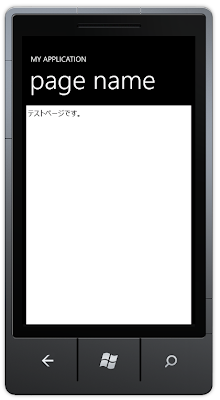I was also struggling the problem when I made binding between data source and UI ListBox target.
Today, I'd like to introduce the problem that we
cannot bind "non-INotifyPropertyChanged property" and "INotifyPropertyChanged property" to same ListBox target.
First, I had written property binding like this. I had used "non-INotifyPropertyChanged property".
<ListBox Height="595" ItemsSource="{Binding}" HorizontalAlignment="Left" Margin="12,6,0,0" Name="listBox1" VerticalAlignment="Top" Width="438">
<ListBox.ItemTemplate>
<DataTemplate>
<StackPanel HorizontalAlignment="Stretch" Orientation="Horizontal">
<TextBlock x:Name="Name1" FontSize="35" Text="{Binding Text1}" Foreground="Black"/>
<TextBlock x:Name="Name2" FontSize="35" Text="{Binding Text2}" Foreground="Black"/>
</StackPanel>
</DataTemplate>
</ListBox.ItemTemplate>
</ListBox>
public partial class MainPage : PhoneApplicationPage
{
// Constructor
public MainPage()
{
InitializeComponent();
GetList();
}
public void GetList()
{
List<ItemProperties> items = new List<ItemProperties>();
items.Add(new ItemProperties { Text1 = "test01", Text2 = "test02" });
items.Add(new ItemProperties { Text1 = "test11", Text2 = "test12" });
listBox1.ItemsSource = items;
}
}
public class ItemProperties
{
private string m_Text1;
public string Text1
{
get { return m_Text1; }
set { m_Text1 = value; }
}
private string m_Text2;
public string Text2
{
get { return m_Text2; }
set { m_Text2 = value; }
}
}
Second, I wanted to bind Foreground color in ListBox. So, I added "INotifyPropertyChanged property" as Foreground colors.
The code is like this. But I found I couldn't bind "INotifyPropertyChanged property" to Foreground color in this code.
<ListBox Height="595" ItemsSource="{Binding}" HorizontalAlignment="Left" Margin="12,6,0,0" Name="listBox1" VerticalAlignment="Top" Width="438">
<ListBox.ItemTemplate>
<DataTemplate>
<StackPanel HorizontalAlignment="Stretch" Orientation="Horizontal">
<TextBlock x:Name="Name1" FontSize="35" Text="{Binding Text1}" Foreground="{Binding Color1}"/>
<TextBlock x:Name="Name2" FontSize="35" Text="{Binding Text2}" Foreground="{Binding Color2}"/>
</StackPanel>
</DataTemplate>
</ListBox.ItemTemplate>
</ListBox>
public partial class MainPage : PhoneApplicationPage
{
public ObservableCollection<ItemProperties2> ItemCollection { get; private set; }
// Constructor
public MainPage()
{
InitializeComponent();
GetList();
GetList2();
}
public void GetList()
{
List<ItemProperties> items = new List<ItemProperties>();
items.Add(new ItemProperties { Text1 = "test01", Text2 = "test02" });
items.Add(new ItemProperties { Text1 = "test11", Text2 = "test12" });
listBox1.ItemsSource = items;
}
public void GetList2()
{
ItemCollection = new ObservableCollection<ItemProperties2>();
ItemCollection.Add(new ItemProperties2
{
Color1 = new SolidColorBrush(Colors.LightGray),
Color2 = new SolidColorBrush(Colors.Brown)
});
ItemCollection.Add(new ItemProperties2
{
Color1 = new SolidColorBrush(Colors.Cyan),
Color2 = new SolidColorBrush(Colors.Red)
});
DataContext = ItemCollection;
}
}
public class ItemProperties
{
private string m_Text1;
public string Text1
{
get { return m_Text1; }
set { m_Text1 = value; }
}
private string m_Text2;
public string Text2
{
get { return m_Text2; }
set { m_Text2 = value; }
}
}
public class ItemProperties2 : INotifyPropertyChanged
{
public event PropertyChangedEventHandler PropertyChanged;
public ItemProperties2() { }
private Brush m_Color1;
public Brush Color1
{
get { return m_Color1; }
set
{
m_Color1 = value;
OnPropertyChanged("Color1");
}
}
private Brush m_Color2;
public Brush Color2
{
get { return m_Color2; }
set
{
m_Color2 = value;
OnPropertyChanged("Color2");
}
}
protected void OnPropertyChanged(string name)
{
PropertyChangedEventHandler handler = this.PropertyChanged;
if (handler != null)
handler(this, new PropertyChangedEventArgs(name));
}
}
It seems that "non-INotifyPropertyChanged property" is given priority over "INotifyPropertyChanged property".
I think the problem is a little foolish in now. But If your code is quite large amount, you may not be able to find the problem immediately.
I write previous blog post as
the answer for the problem. Please check it also.













